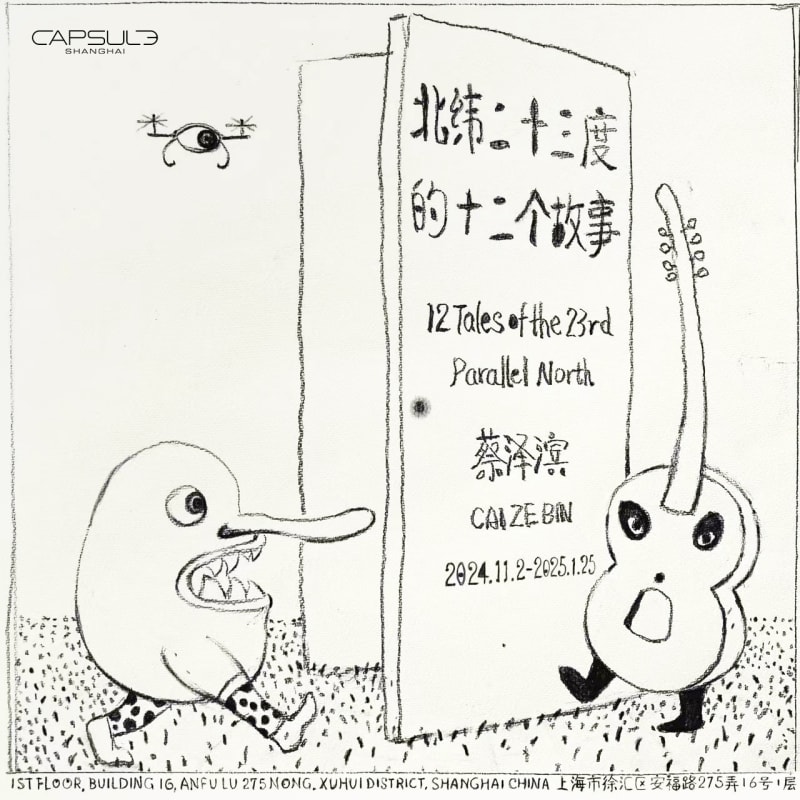Capsule Shanghai is honored to present artist Cai Zebin’s third solo exhibition at the gallery, 12 Tales of the 23rd Parallel North. The exhibition showcases the artist’s recent paintings, unveiling his multifaceted exploration of creative approaches and language, along with the rich implications within his visual compositions.
“The 23rd Parallel North” in the exhibition title refers to the region of Shantou where the artist lives and works. In the twelve paintings on view, he captures moments from dusk to night. Temporarily shifting away from the “palette person” series that had been the core of his practice for three years, Cai, over the last two years, redirects his exploration to life around his hometown. Starting from the self-awareness of his identity as a painter, the artist acts as both the witness and the creator of the portrayed scenes, constructing a mystical world where everything is imbued with life and soul.
Cai's inspirations never stray far from everyday life. Streams of fantastical imaginings flow in his mind like characters in Ulysses that wander and converse in the city. Stringing together the imaginings through first-hand experiences and feelings, he creates images that are both originary and memorial. When objects from reality enter his view, his visual sensitivity breeds illusory beings detached from reality - a process deeply influenced by his non-representational approach towards the surroundings. It is therefore challenging to find in his “tales” a direct correspondence with real time and space. However, the lying origami’s flimsy texture and sense of spatial folding suggest exhaustion and powerlessness. Kafka’s The Metamorphosis, Odilon Redon’s The Crying Spider, and Kamaji (the Boiler Geezer) in Spirited Away by Miyazaki Hayao all inspire a perfect sense of formal contrast. As the figures’ facial expressions fade, an overall serenity emerges from the paintings.
This emotionlessness is also evident in the omission of facial features, such as the absence of mouths in Ni Hao and Hello, the use of simple holes in lieu of eyes in The Story of the Shadow and Self-portrait - Metamorphosis, and the insect-shaped table in Glimmer. On the other hand, when exaggerated eyes are paired with subtle curves, the protagonists in Confusion at Midnight look adequately bemused; Greetings of the Detective presents certain questions; The Song of the Big Shot has an undertone of humor and wit.
Cai frequently merges facial expressions with body parts, such as the fish in place of the magician’s face (Ichthyic Magician), and the mutants in The Painter With a Long Nose and Dancing Phantom, among other examples of hybridization in his works. The figures are enlarged to a remarkable scale, from which grows distorted limbs that direct the viewer’s gaze to a maze of details. The protagonists serve as the central junction of the painted image, connecting myriads of hidden clues. Elements of Alberto Giacometti's sculptures, Victor Brauner's paintings, Grant Wood's landscapes, and elements from Cai’s previous works are ingeniously woven into the paintings.
The artist often replicates classic works of admired masters as a way to study them, similar to the practice of “learning from the ancients” (shī gǔ, 师古) in traditional Chinese painting. However, his focus is on capturing the spirit and essence of the classic works. The vast collection of Cai’s manuscripts attests to an evolving process of comprehension and transformation - the same process through which Magritte’s Perspective II: Manet’s Balcony Studywas born out of Manet’s The Balcony. Cai’s construction of small components into large compositions differs fundamentally from Lothar Ledderose's notion of module for the purpose of mass production, as the latter does not require complex thinking or transformation. From Breath by Samuel Beckett, The Maze (published in the US under the title There Once Lived a Woman Who Tried to Kill Her Neighbor's Baby: Scary Fairy Tales) by Lyudmila Petrushevskaya, to cultural activities from the region of Chaoshan, imaginations conjured from literature and folk customs are implanted into the artist’s thinking. It is through the reconstruction of painterly vocabulary and visual communication that the artist’s subjectivity is revealed.
In addition to juxtaposing body parts, Cai often anthropomorphizes everyday scenes. The fountain statue morphs into a crying person in a mystical concurrence of sun and moon. The richly textured wasp nest, while resembling a sculpture, grows limbs brimming with vitality. The artist infuses imagination into symbolism to form a narrative – a process that he unravels in a series of artist books, shedding light on his pursuit of knowledge and artistic vision. Each figure in his painting is both a reflection of the Self and a construct of the Other, embodying the transformation from object to image.
“Concise but not simplistic.” Cai Zebin conceals the surreal within fragments of reality, like the open book depicted in the exhibition’s poster, where each page is a portal to endless possibilities.
Text by Meng Xianhui



